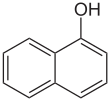1-Naphthol
1-Naphthol, or α-naphthol, is a fluorescent organic compound with the formula C10H7OH. It is a white solid. It is an isomer of 2-naphthol differing by the location of the hydroxyl group on the naphthalene ring. The naphthols are naphthalene homologues of phenol, with the hydroxyl group being more reactive than in the phenols. Both isomers are soluble in simple alcohols, ethers, and chloroform. They are precursors to a variety of useful compounds. Naphthols (both 1 and 2 isomers) are used as biomarkers for livestock and humans exposed to polycyclic aromatic hydrocarbons.[1]
| |||
| Names | |||
|---|---|---|---|
| IUPAC name
Naphthalen-1-ol | |||
| Other names
1-Hydroxynaphthalene; 1-Naphthalenol; alpha-Naphthol | |||
| Identifiers | |||
3D model (JSmol) |
|||
| ChEBI | |||
| ChEMBL | |||
| ChemSpider | |||
| ECHA InfoCard | 100.001.791 | ||
| KEGG | |||
PubChem CID |
|||
| UNII | |||
CompTox Dashboard (EPA) |
|||
| |||
| |||
| Properties | |||
| C10H8O | |||
| Molar mass | 144.17 g/mol | ||
| Appearance | Colorless or white solid; commercial material is often strongly colored | ||
| Density | 1.10 g/cm3 | ||
| Melting point | 95 to 96 °C (203 to 205 °F; 368 to 369 K) | ||
| Boiling point | 278 to 280 °C (532 to 536 °F; 551 to 553 K) | ||
| -98.2·10−6 cm3/mol | |||
Except where otherwise noted, data are given for materials in their standard state (at 25 °C [77 °F], 100 kPa). | |||
| Infobox references | |||
Production
1-Naphthol is prepared by two main routes.[2] In one method, naphthalene is nitrated to give 1-nitronaphthalene, which is hydrogenated to the amine followed by hydrolysis:
- C10H8 + HNO3 → C10H7NO2 + H2O
- C10H7NO2 + 3 H2 → C10H7NH2 + 2 H2O
- C10H7NH2 + H2O → C10H7OH + NH3
Alternatively, naphthalene is hydrogenated to tetralin, which is oxidized to 1-tetralone, which undergoes dehydrogenation.
Occurrence and degradation
1-Naphthol is a metabolite of the insecticide carbaryl and naphthalene. Along with TCPy, it has been shown to decrease testosterone levels in adult men.[3]
It biodegrades via formation of 1-naphthol-3,4-oxide, which converts to 1,4-naphthoquinone.[4]
Applications
1-Naphthol is a precursor to a variety of insecticides including carbaryl and pharmaceuticals including nadolol[5][6] as well as for the antidepressant sertraline[7] and the anti-protozoan therapeutic atovaquone.[8] It undergoes azo coupling to give various azo dyes, but these are generally less useful than those derived from 2-naphthol.[2][9]
Other uses
In Molisch's test, 1-naphthol dissolved in ethanol, known as Molisch's reagent, is used as reagent for detecting the presence of carbohydrates. The test known as Molisch's test would give a red- or purple-colored compound to indicate the presence of carbohydrate. The rapid furfural test, similar to Molisch's test, also uses 1-naphthol.
The Sakaguchi test uses 1-naphthol with sodium hypobromite to detect the presence of arginine in proteins.
The Voges–Proskauer test uses 1-naphthol in potassium hydroxide (KOH) solution to detect the breakdown of glucose into acetoin which is used by bacteria for external energy storage. A positive test will be indicated by the appearance of a red color of the original yellow solution.
References
- Sreekanth, R; Prasanthkumar, KP; Sunil Paul, MM; Aravind, UK; Aravindakumar, CT (7 November 2013). "Oxidation reactions of 1- and 2-naphthols: an experimental and theoretical study". The Journal of Physical Chemistry A. 117 (44): 11261–70. doi:10.1021/jp4081355. PMID 24093754.
- Gerald Booth "Naphthalene Derivatives" in Ullmann's Encyclopedia of Industrial Chemistry, 2005, Wiley-VCH, Weinheim. doi:10.1002/14356007.a17_009.
- Meeker, John D.; Ryan, Louise; Barr, Dana B.; Hauser, Russ (January 2006). "Exposure to Nonpersistent Insecticides and Male Reproductive Hormones". Epidemiology. 17 (1): 61–68. doi:10.1097/01.ede.0000190602.14691.70. PMID 16357596.
- Yoshito Kumagai; Yasuhiro Shinkai; Takashi Miura; Arthur K. Cho (2011). "The Chemical Biology of Naphthoquinones and Its Environmental Implications". Annual Review of Pharmacology and Toxicology. 52: 221–47. doi:10.1146/annurev-pharmtox-010611-134517. PMID 21942631.
- M.E. Condon; et al. (1978), "Nondepressant β-adrenergic blocking agents. 1. Substituted 3-amino-1-(5,6,7,8-tetrahydro-1-naphthoxy)-2-propanols", J. Med. Chem. (in German), 21 (9), pp. 913–922, doi:10.1021/jm00207a014
- DE 2258995, F.R. Hauck, C.M. Cimarusti, V.L. Narayan, "2,3-cis-1,2,3,4-Tetrahydro-5[2-hydroxy-3-(tert.-butylamino)-propoxy]-2,3-naphthalindiol"
- K. Vukics; T. Fodor; J. Fischer; I. Fellevári; S. Lévai (2002), "Improved industrial synthesis of antidepressant Sertraline", Org. Process Res. Dev. (in German), 6 (1), pp. 82–85, doi:10.1021/op0100549
- B.N. Roy; G.P. Singh; P.S. Lathi; M.K. Agarwal (2013), "A novel process for synthesis of Atovaquone" (PDF), Indian J. Chem. (in German), 52B, pp. 1299–1312
- C. Kaiser; T. Jen; E. Garvey; W.D. Bowen; D.F. Colella; J.R. Wardell Jr. (1977), "Adrenergic agents. 4. Substituted phenoxypropanolamine derivatives as potential β-adrenergic agonists", J. Med. Chem. (in German), 20 (5), pp. 687–689, doi:10.1021/jm00215a014

